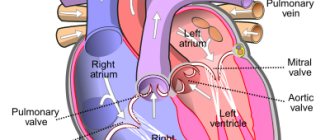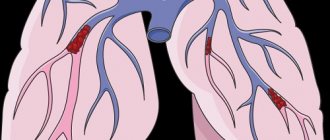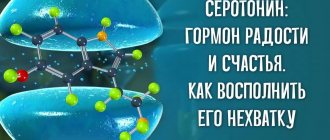Every fourth stroke develops in the posterior parts of the brain in the area of responsibility of the vertebral arteries. Atherosclerosis and narrowing of the vertebral artery
can occur in any part of it and can cause ischemic stroke. Unlike narrowing of the carotid arteries, the role of which in the development of stroke has been known for a long time and methods for their treatment have been developed, the pathology of the vertebral arteries has not yet been sufficiently studied. However, modern technologies for diagnostic testing and endovascular treatment methods have opened up new opportunities for intervention in this disease.
Vertebral artery syndrome is a condition associated with obstruction of the patency manifested by symptoms of cerebrovascular insufficiency in the posterior part of the brain.
The causes of impaired patency can be very different, so the main task in the management of patients is an accurate diagnosis, so that as soon as the identification of the exact cause will allow it to be eliminated and the symptoms that are painful for patients to be removed. Every year the disease becomes younger, which is associated with an increase in the number of young people who sit for long periods at computers and have a sedentary lifestyle.
Timely diagnosis guarantees a favorable result of treatment of vertebral artery syndrome in our clinic.
Causes of vertebral artery syndrome
The most common cause of vertebral artery circulatory disorders is atherosclerotic plaque. Less common are stratification (dissection) of the artery, compression of it in the neck or at the entrance to the skull, and inflammatory diseases (vasculitis). It is quite difficult to accurately determine the likelihood of developing a stroke with such a localized lesion. According to anatomical studies, damage to the vertebral arteries during death from ischemic stroke was observed in 12% of cases.
Damage to the intracerebral parts of the vertebrobasilar system more often leads to ischemic strokes than narrowing of the artery in the neck. The risk of developing ischemic events with such lesions is about 7% per year. Symptoms of vertebral artery syndrome are being diagnosed more and more often. Many factors influence the development of the syndrome. It usually represents a combination of cerebrovascular arteriosclerosis and cervical spondylosis (degenerative changes in intervertebral disc tissue) as the main clinicopathological components.
Treatment
Treatment of vertebral (vertebral) artery syndrome consists of two main areas: improving hemodynamics and treating diseases that lead to compression of the vertebral arteries.
Drug treatment
Anti-inflammatory and decongestant therapy is aimed at reducing perivascular edema resulting from mechanical compression. Drugs that regulate venous outflow (troxerutin, ginkgo biloba, diosmin). NSAIDs (Celebrex, lornoxicam, celecoxib)
Vascular therapy is aimed at improving blood circulation in the brain, since hemodynamic disturbances occur in 100% of patients with this syndrome. Modern diagnostic methods make it possible to evaluate the effectiveness of treatment with these drugs and the dynamics of blood flow in the vessels of the brain using ultrasound examination. The following drugs are used for vascular therapy: purine derivatives (trental), vinca derivatives (vincamine, vinpocetine), calcium antagonists (nimodipine), alpha-blockers (nicergoline), instenon sermion.
Neuroprotective therapy
One of the most modern areas of drug treatment is the use of drugs to improve energetic processes in the brain, which allows minimizing neuronal damage due to episodic circulatory disorders. Neuroprotectors include: cholinergic drugs (citicoline, gliatiline), drugs that improve regeneration (Actovegin, Cerebrolysin), nootropics (piracetam, Mexidol), metabolic therapy (mildronate, Thiotriazoline, Trimetazidine)
Symptomatic therapy includes the use of drugs such as muscle relaxants, antimigraine drugs, antihistamines and others.
Treatment of degenerative diseases includes non-drug treatment methods, such as exercise therapy, physiotherapy, massage, acupuncture, and manual therapy.
In most cases, the use of complex treatment, including both drug and non-drug treatment, can reduce symptoms and improve blood circulation in the brain.
Surgical treatment methods are used in cases where there is severe compression of the arteries (disc herniation, osteophyte) and only surgical decompression can achieve a clinical result.
Forecast
With atherosclerosis of the vertebral artery, it is quite difficult to give a prognosis for the life and health of the patient. With large narrowings, blood flow is compensated by the second vertebral artery; in addition, there is collateral blood flow. There have not yet been large studies assessing the risk of stroke with damage to the vertebral arteries. However, the fact remains that strokes in the vertebrobasilar system account for at least 25% of all strokes and are much more severe than strokes associated with the carotid artery. Therefore, the identification of significant narrowing of the vertebral artery should be a reason to eliminate this risky condition.
Without identifying and eliminating the causes of the development of vertebral artery syndrome, the prognosis for recovery is unfavorable. Most often, the patient's condition gradually worsens, which negatively affects the quality of life.
The most difficult thing is to identify the exact cause. Knowing the cause will allow it to be eliminated surgically or endovascularly and relieve the patient from painful symptoms.
Symptoms
You can start sounding the alarm when you experience severe headaches (sometimes a banal touch to your hair is akin to a disaster). It is this symptom that is considered primary. Patients note a burning and throbbing nature of the pain. Discomfort in this case spreads from the occipital region to the crown and temples, after which it rushes to the superciliary region. More often, the pain is constantly present, but sometimes it can appear paroxysmal, intensifying while sleeping in an uncomfortable position or when walking. A sudden change in head position may well lead to the development of nausea and even vomiting. Sometimes a disturbance of consciousness is recorded, before which the patient notes numbness of the face and impaired speech.
Despite the increased pain even with minor movements, a person can find a comfortable head position in which the pain subsides partially or completely.
The next symptom is ophthalmological disorders. Visual acuity decreases sharply, a kind of veil appears before the eyes, and the eyeballs may hurt. In some cases, there may be a feeling of “sand” in the eyes and dryness.
Auditory and vestibular disorders are also not uncommon. Tinnitus appears and hearing acuity decreases. The dizziness that occurs (mainly manifests itself after sleeping in an uncomfortable position/on a high pillow) is non-systemic in nature.
Patients suffering from cardiac pathologies may experience manifestations of a cardiac nature: increased blood pressure, pressing pain in the chest.
Depression is another sign indicating the possible development of cervical migraine. The condition is caused by impaired blood supply to the brain, as well as purely emotional moments (fear of another attack of tinnitus or headache).
If the symptoms of the pathology are not recognized in a timely manner or treatment is refused, the situation may worsen in the future, complicated by a transient circulatory disorder. It will entail complete or partial loss of vision, impaired coordination of movements/swallowing/speech.
The similarity of the symptoms of cervical migraine with the symptoms of acute cerebrovascular accident should be taken into account. If you notice severe dizziness, unbearable headache, double vision and gait disturbance, you should immediately seek specialized help!
Folk remedies
Therefore, together with massage, medications and physiotherapeutic procedures, various folk remedies can be used.
- Pine baths are good for relaxing and relieving muscle spasms.
- A tincture of grated garlic, honey and lemon juice improves blood circulation and thins the blood. You need to take it one tablespoon before bed.
- A decoction of sunflower roots helps remove salts from the body, which are often deposited on the vertebrae during osteochondrosis. A liter of this decoction is drunk per day.
- A compress of grated horseradish effectively relieves pain. The paste of this root is placed on a linen napkin on the neck area, covered with cellophane and wrapped warmly.
- Brew oregano: 2 tablespoons of herbs per liter of boiling water. Infuse all night, drink in four doses the next day. This infusion is good for dizziness.
Physiotherapy
Physiotherapeutic treatment helps eliminate many problems with impaired blood flow through the vessels that supply the brain. In such pathological conditions, a specialist can decide on the advisability of prescribing UHF therapy, electrophoresis, mud applications, magnetic therapy, etc. to the patient. These modern techniques can improve the nutrition of the central nervous system, eliminate the manifestations of the disease, normalize blood flow, reduce tissue swelling and relieve local inflammation. Before physiotherapeutic treatment, you should consult a doctor. For more detailed information, you can follow the link.
Physiotherapeutic methods
In the acute phase of the disease, physiotherapy helps block pain impulses along sympathetic nerve fibers. For this we use:
- diadynamic current for 5 minutes;
- ultrasound in pulsed mode;
- phonophoresis with solutions of Analgin, Anestezin;
- electrophoresis with ganglion blockers;
- d'Arsonval's currents on his head.
In the subacute stage, you can use electrophoresis with iodine, Novocaine, Euphyllin, Papaverine.
Reliable physiotherapeutic methods include: acupuncture, galvanization of the collar area. An individual mode of pulsed currents and ultrasound is also selected.
Lifestyle change
For a full course of treatment, doctors recommend changing your attitude towards familiar things:
- reduce salt intake with food;
- if necessary, quit smoking and lose weight;
- adjust your work and rest schedule, get enough sleep;
- if there is a high level of cholesterol in the blood, you need to reduce the amount of fat consumed;
- be less nervous, and if stressful situations develop, use sedatives;
- To relieve pain, it is recommended to wear a Chance collar at home, and, if possible, at work, which reduces the load on the cervical spine.
Why doctors often fail to make an accurate diagnosis
Earlier we saw that in clinical medicine the field of neurology is separated from the field of cardiology. This is explained by the fact that in the last century such doctors worked in teams. Each had a little information from a related discipline, which was enough to attract a colleague, but not enough to make a diagnosis by one specialist.
After a series of reforms in medicine, this connection (not ideal, but quite working previously) turned out to be weakened. This means that in one clinic doctors still work as a team and can make the correct diagnosis, while in another there are not enough specialists. In the second case, the neurologist conducting the appointment “sags” not because he is not competent, but because he was not provided with contact with cardiologists. Similarly, a cardiologist may find it difficult to make a diagnosis because he does not have a connection with neurologists.
Doctor's advice. What to do if your back hurts, your blood pressure fluctuates, or you feel dizzy?
First, do exercises for your neck; it definitely won’t harm you and will definitely improve your condition. Secondly, make an appointment under your compulsory medical insurance policy with a neurologist and cardiologist. Get a full examination, follow nutritional recommendations, but do not rush to take medications.
Procedures
The most popular treatments for SPA arising from cervical osteochondrosis are diadynamic therapy, UHF therapy, laser therapy, magnetic therapy, and shock wave therapy. Patients are prescribed up to 10 procedures to improve blood supply to damaged tissues and all parts of the brain with oxygen and nutrients. Physical factors used during procedures (ultrasound vibrations, electric current pulses) help accelerate lymphatic drainage and recovery processes.
If SPA is accompanied by pain in the neck and back of the head, then electrophoresis or ultraphonophoresis with analgesics and anesthetics is used.
Massage
SPA therapy uses classic, acupressure, and vacuum massage. But the myofascial massage technique is especially useful, which aims to eliminate pathological tension in the muscles of the neck and shoulder girdle. The massage therapist works on muscle fibers, tendon edges, muscle attachments, and fascia. Before starting the procedure, he palpates the trigger areas - areas of tension, areas of severe pain, small round lumps formed in the muscle tissue.
Exercises
To relieve tonic tension in the neck muscles, post-isometric relaxation is used - a combination of gentle manual therapy with exercise therapy. Patients exercise under the guidance of a doctor, who sets the direction of movements and doses physical activity. Stretching exercises are performed during classes. They help to increase the spaces between the vertebrae and eliminate compression of the vertebral artery. A physical therapy doctor may prescribe the following exercises:
- sit down and place your interlocked fingers on the back of your head. Try to throw your head back, resisting with your hands for 20 seconds. Repeat the exercise with your head tilted down, placing your hands under your chin;
- sit down, place your palm on your cheek. Turn your head in this direction, resisting with your hand. Perform the exercises in the other direction.
These exercises allow you to strengthen your neck muscles without putting stress on damaged discs and vertebrae. The therapeutic effect of gymnastics appears only with regular training.
Traditional methods
SPA is characterized by symptoms that cannot be eliminated with the help of folk remedies. Rubbing and infusions are ineffective for drop attacks, visual and auditory disorders. Their mild sedative effect is unsafe for dizziness and lack of coordination of movements. After the main therapy, with the permission of the doctor, you can use vodka rubbing.
Surgical intervention
If the cause of spasm cannot be eliminated using conservative methods, surgery is performed. An indication for it is also the threat of ischemic brain damage. During surgery, compression of the vertebral artery is eliminated, bone growths are excised, and the blood vessel is reconstructed. If necessary, sections of the adventitial sheath of the artery containing nerve fibers are removed, or the branches of the sympathetic nerves are dissected (periarterial sympathectomy).









